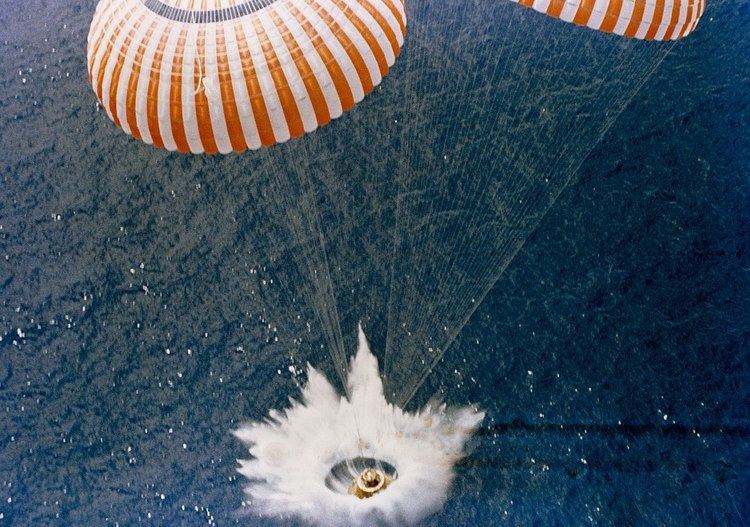 | ||
Splashdown is the method of landing a spacecraft by parachute in a body of water. It was used by American manned spacecraft prior to the Space Shuttle program, and is planned for use by the upcoming Orion Multipurpose Crew Vehicle. It is also possible for the Russian Soyuz spacecraft to land in water, though this is only a contingency. The only example of an unintentional manned splashdown in Soviet history is the Soyuz 23 landing.
Contents
As the name suggests, the capsule parachutes into an ocean or other large body of water. The properties of water cushion the spacecraft enough that there is no need for a braking rocket to slow the final descent as is the case with Russian and Chinese manned space capsules, which return to Earth over land. The American practice came in part because American launch sites are on the coastline and launch primarily over water. Russian launch sites are far inland and most early launch aborts were likely to descend on land.
Missions
The splashdown method of landing was utilized for Mercury, Gemini and Apollo (including Skylab, which used Apollo capsules). On one occasion a Soviet spacecraft, Soyuz 23, punched through the ice of a frozen lake (nearly killing the cosmonauts), and this was unintentional.
On early Mercury flights, a helicopter attached a cable to the capsule, lifted it from the water and delivered it to a nearby ship. This was changed after the sinking of Liberty Bell 7. All later Mercury, Gemini and Apollo capsules had a flotation collar (similar to a rubber life raft) attached to the spacecraft to increase their buoyancy. The spacecraft would then be brought alongside a ship and lifted onto deck by crane.
After the flotation collar is attached, a hatch on the spacecraft is usually opened. At that time, some astronauts decide to be hoisted aboard a helicopter for a ride to the recovery ship and some decided to stay with the spacecraft and be lifted aboard ship via crane. (Because of his overshoot aboard Aurora 7, and mindful of the fate of Liberty Bell 7, Scott Carpenter alone egressed through the nose of his capsule instead of through the hatch, waiting for recovery forces in his life raft.) All Gemini and Apollo flights (Apollos 7 to 17) used the former, while Mercury missions from Mercury 6 to Mercury 9, as well as all Skylab missions and Apollo-Soyuz used the latter, especially the Skylab flights as to preserve all medical data. During the Gemini and Apollo programs, NASA used MV Retriever for the astronauts to practice water egress.
Apollo 11 was America's first moon landing mission and marked the first time that humans walked on the surface of another planetary body. The possibility of the astronauts bringing "moon germs" back to Earth was remote, but not impossible. To contain any possible contaminants at the scene of the splashdown, the astronauts donned special Biological Isolation Garments and the outside of the suits were scrubbed prior to the astronauts being hoisted aboard USS Hornet and escorted safely inside a Mobile Quarantine Facility.
The early design concept for the new U.S. Orion Crew Exploration Vehicle featured recovery on land using a combination of parachutes and airbags, although it was also designed to make a contingency splashdown (only for an in-flight abort) if needed. Due to weight considerations, the airbag design concept was dropped. The present design concept features landings via splashdown in the Pacific Ocean off the coast of California.
Disadvantages
The most dangerous aspect is the possibility of the spacecraft flooding and sinking. For example, when the hatch of Gus Grissom's Mercury-Redstone 4 capsule blew prematurely, the capsule sank and Grissom almost drowned.
Despite the fact that water helps cushion the spacecraft's landing to an extent, the impact can still be quite violent for the astronauts.
If the capsule comes down far from any recovery forces the crew are exposed to greater danger. As an example, Scott Carpenter in Mercury 7 overshot the assigned landing zone by 400 kilometers (250 mi). These recovery operation mishaps can be mitigated by placing several vessels on standby in several different locations, but this is quite an expensive option.
Manned spacecraft
** Planned recovery ship
